Adrian Collins's Blog, page 139
April 27, 2022
Mark Lawrence: Endings
Endings are difficult. I thought perhaps that someone famous and wise had said that, and that with the aid of Google I might be able to quote them, and seem wise by association. But the truth is that it’s so obvious there’s no original source to quote from. Breaking up is hard to do – there! I found someone to quote. Neil Sedaka said it for us in song.
The full quote is:
Do do do, Down dooby doo down down,
Comma, comma, down dooby doo down down,
Comma, comma, down dooby doo down down,
Breaking up is hard to do.
 But let’s not dwell on that. The point is that whether it’s the last page of a book, or a windswept street corner at 3am after a party in Wandsworth 1985 … breaking up is hard to do. Endings are difficult.
But let’s not dwell on that. The point is that whether it’s the last page of a book, or a windswept street corner at 3am after a party in Wandsworth 1985 … breaking up is hard to do. Endings are difficult.
Endings are important. Quite how important depends on the reader. Stephen King is a favourite of mine and of a great many other people, and yet the man can only write a good ending to a book by accident. With King, I enjoy the journey, and even if the destination isn’t what I’d hoped for, I still enjoyed the journey and want to take another trip.
Some readers, however, are all about the destination. They subscribe to the ‘rat turd in your cereal’ philosophy. The rat turd might only be a tiny percentage of the contents of your cereal bowl, but you’re unlikely to just eat around it – the breakfast is ruined.
Both approaches have valid things to say. The ending is often what stays with a reader and stands in as shorthand for the whole book.
Endings are hard, because in the body of the book pacing is more flexible. You can put off this task or that task, knowing that you’ll have time to get to it later. You can seed new elements to the story, assuming that at some point they will weave seamlessly together. You can build your hero and your villain (if you have them) in isolation from each other, piling strength on strength.
But in the end … it all has to come together. One element rushes headlong into the next in the diminishing space available, and you have to hope (or better still, engineer through writing skill) that they join together to make something greater than the sum of their parts.
The Girl And The Moon is the final book in The Book of the Ice. So, not only do the last few pages constitute the end of the book they’re sitting in, but they bring to an end a story that has occupied two other books as well.
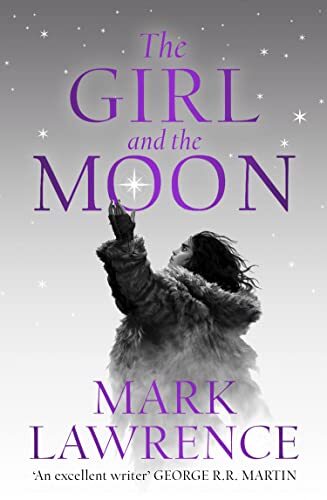 Over and above that, The Girl And The Moon ends threads and elements that loosely connect The Broken Empire trilogy, The Red Queen’s War trilogy, The Book of the Ancestor trilogy, and The Impossible Times trilogy. So, now there are 15 books, FIFTEEN, all peering over my shoulder as I bash out the final chapter of The Girl And The Moon.
Over and above that, The Girl And The Moon ends threads and elements that loosely connect The Broken Empire trilogy, The Red Queen’s War trilogy, The Book of the Ancestor trilogy, and The Impossible Times trilogy. So, now there are 15 books, FIFTEEN, all peering over my shoulder as I bash out the final chapter of The Girl And The Moon.
The connections among these books are, as I mentioned, loose, and I had no intention of writing a Third Book of the Ice that required a reader have read and memorised all 14 of my other books. Many of the connections are subtle and will be noticed only by the dedicated Lawrence reader. The book is designed to be enjoyed by a reader who misses ALL of the connections.
I invent my stories as I tell them. I’m what George RR Martin calls ‘a gardener’. Like him, I throw out seeds and see what grows. It’s a nice analogy but insufficient to describe the process. If you just throw out seeds and leave it at that, you will end up with a hotchpotch garden with splashes of colour here and there. A wild meadow, basically. Some may find it pretty but it’s not exactly gardening. A gardener has to employ some tools and bring a degree of order. Quite how much depends on taste. Whether you want the ornamental garden of a stately home or the chaotic sprawl of a wildlife garden, you still need to put in the work, if only to control the weeds.
For me the second phase of any novel or trilogy, after having begun to sow those seeds, is to make connections. To see that this one thing fits nicely with that other thing. To bring together disparate elements in ways that solve problems, and eventually direct what might otherwise be a sprawling mess into a steadily narrowing focus.
It’s the ability to make these connections and focus a story that always amazes me. It’s never something that I feel confident will happen. And yet, time and again, it has happened. I have found that this character, that power, these locations, can be combined in some unexpected way to reduce the number of variables while generating excitement, and eventually bringing us to a conclusion.
The same process of connection can occur over a trilogy rather than just across the span of one particular book. And, of course, it can occur over multiple trilogies. The inclusion of trilogy spanning connections is somewhat of a two-edged sword though. These overarching threads can excite and intrigue readers, but they can also (wrongly) put readers off.
When a writer sends a book to an agent or publisher seeking publication they know that the person at the other end is drowning in manuscripts and thus is naturally looking for reasons to swiftly discard as many as possible. These days, most readers seem to have a to-be-read stack of books that towers so high that its collapse might cause casualties. And this moves them, reading-wise, closer to the agent/publisher. Readers actively look for a reason NOT to read new books, because they already have more than they can cope with.
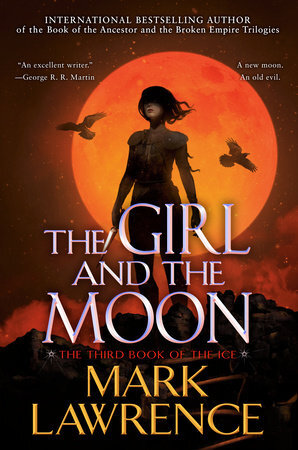 As such, the implication that this new trilogy is linked to an older one that the reader hasn’t read, can instantly be taken as a reason not to read the new trilogy. The reader feels that they will miss out on something important, it will be like starting a series on book 3. Why bother? Thus, my reluctance to acknowledge the tenuous connections across my trilogies. I don’t want to give the reader an excuse to turn away from the newest offering.
As such, the implication that this new trilogy is linked to an older one that the reader hasn’t read, can instantly be taken as a reason not to read the new trilogy. The reader feels that they will miss out on something important, it will be like starting a series on book 3. Why bother? Thus, my reluctance to acknowledge the tenuous connections across my trilogies. I don’t want to give the reader an excuse to turn away from the newest offering.
Yes, Doctor Taproot appears in every trilogy I’ve written. But the important part is that I have never written a book where knowing this fact is required to enjoy the book. I write the best books I can – and then there’s this extra thing that might make a subset of the readers smile.
Imagine someone told you after you read The Lord of the Rings, that the Silmarillion also exist. It’s like that. A generation read and loved The Lord of the Rings without knowing the Silmarillion existed. JRRT wrote the best book he could, and your enjoyment was not blunted because you didn’t know what Galadriel got up to in her childhood. It’s the same sort of thing here. Not that I’m claiming to be JRRT.
I lay all this out to illustrate the difficulty of ending such a thing. The quandary of giving endings to threads and characters that the reader of only this trilogy may not even be aware are woven and/or walking through the pages. There is, for example, one character many readers will be intimately familiar with, but who weaves themself through this story so subtly that even their greatest admirers may miss the evidence of their fingerprints on the tale.
One reader well versed in the ways of this particular character reached the reveal and messaged me to say “You absolute madman, you actually did it!”. Another, who had also followed the character through many books, missed their presence entirely and yet still 5★ed The Girl And The Moon and reviewed it with lavish praise. So, in the final analysis, I feel that the undercurrents of the many books reach a confluence here that will bring a measure of satisfaction to the sharp-eyed Lawrence devotee, whilst having no negative impact whatsoever on the ability of a newbie to devour The Girl And The Moon with maximum enjoyment.
But it wasn’t an easy needle to thread!
I’ll finish with mention of one of the least satisfying but also wisest endings I’ve read. Namely, the ending in book 13 of A Series Of Unfortunate Events, aptly called The End, wherein Lemony Snicket leaves a great many important storylines hanging and uses them to underscore his main point: that a story never truly begins nor ends, and a book is merely a sliding window over events, page 1 not commencing the narrative any more than the final page can halt it.
I’ve not followed Lemony’s approach. I have provided the very best ending I can achieve. But it is true, that the story began before I chose to start chronicling it, and will venture forwards in many imaginations, including mine, even though I will no longer pursue it through the keyboard.
Read The Girl and the Moon by Mark LawrenceThe post Mark Lawrence: Endings appeared first on Grimdark Magazine.
April 26, 2022
An Interview with Mark Lawrence
New York Times Bestselling author Mark Lawrence is widely known in the fantasy world as a bit of a chameleon. He is comfortable writing stories that travel in the grimmest of worlds with the most questionable characters to ones of a reality bending fifteen-year-old genius in 1986.
Mark sits down and chats with us about writing, SPFBO, and his newest novel, The Girl and the Moon, the finale to his Book of Ice series.
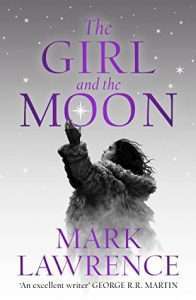 [GdM] You have a degree in physics and hold a Ph.D. in mathematics. Creativity in physics and math is expressed by asking questions and testing them. When plotting a story, do you use the same sort of process? Or is the creative space completely different when writing?
[GdM] You have a degree in physics and hold a Ph.D. in mathematics. Creativity in physics and math is expressed by asking questions and testing them. When plotting a story, do you use the same sort of process? Or is the creative space completely different when writing?
[ML] It’s completely different (for me). Writing is largely an unconscious process as far as I’m concerned. I don’t spend a lot of time running it through my mind. When I do it’s mainly to ask after the event whether it makes sense or not – the “couldn’t the eagles have flown the ring to Mount Doom?” sort of sanity check.
[GdM] What was it like being nominated and shortlisted for a Nobel Peace Prize? I know that it was for a small contribution to the North Carolina Committee on justice reform. It is quite the bucket list item to check off.
[ML] People who say “it was surreal” always annoy me. Show some more originality!
It was surreal. I have a medal from the Governor of North Carolina!
I suspect its most lasting impact will be the smile I have whenever I remember that Voyager decided to put it into my author blurb on the books, including (I think) the 10th anniversary edition of Prince of Thorns. I like to imagine the readers doing double-takes.
[GdM] Your daughter Celyn wrote a book Wheel-Mouse vs. All The Crazy Robots, at age 8, with proceeds going to Children’s Hospice Charities. How did that come about? I read it and loved all the pooing robots.
[ML] It’s a fine piece of literature. I’m surprised she wasn’t the first member of the family nominated for a Nobel Prize. As far as I remember (and it was 10 years ago now – she turned 18 last week) I was just entertaining her and thought we could make a story with someone in a wheelchair so she had someone like her in it – such things were thin on the ground in 2012 and may well still be. So, I asked her lots of questions about who our hero would be, and then what would happen next etc. And at each turn she tended to choose the most “out there” option, and we ended up with Wheel-Mouse battling pooing robots. A classic was born. A semi-finalist for the Goodreads Choice Award for best picture book that year!
[GdM] I read that you DM when playing D&D; in your opinion, what makes a good DM? Is it preparedness or on-the-fly creativity?
[ML] I did DM when I played. I haven’t run a game since my kids were small, but DM is my natural station in such things.
I think maybe the most important ingredient – and the one I lack most – is being a good actor. You have to play the role of many different individuals that the players encounter. Being able to portray them well is a key to bringing the whole thing to life. Sadly, I have all the acting ability of a tree stump, so I had to fall back on storytelling, imagination, preparation, and on-the-fly creativity, all of which are important components too.
The improvisation needs to be kept in check though – I feel that the players like to know there are fixed truths at play, rather than the story is dodging around them just to keep things going. If a character is saved (or killed) by something the DM makes up on the fly, it feels too arbitrary and lacks importance. The players need to know that they have beaten – or been beaten by – a set challenge, and that the improvisation is more about adding colour than about changing the game to let them win.
[GdM] When you build a new story, do you start with the world or a character?
[ML] Almost always with character – though I think with Red Sister I probably decided on the world first (i.e. ice corridor maintained by artificial moon – the rest, including nuns, came as I wrote).
My books are primarily about characters, so character is the place to start for me.
[GdM] What do you think the grimdark as a whole might look like in ten years, and what do you see as the strongest influences of the past five years?
[ML] Now you expose my ignorance. I’m still not entirely sure what grimdark is. According to my own polls, I don’t seem to have written any for 10 years, and I’ve not read a lot of it either. I couldn’t tell you what the influences are or what the future holds. I just write the books I feel like writing, and let other people take care of the rest.
[GdM] From a publishing perspective, are there different expectations of what grimdark is and what is expected from a story dependent on what part of the world you are in?
[ML] I’m not sure I know what this question means. I don’t feel publishers think about grimdark as a subgenre. They seem to consider the word as a synonym for violence, and it’s not a word that I remember seeing printed on either of my main publishers’ books.
If you’re asking whether the US publishers seem any different to the UK publishers in this regard … then no.
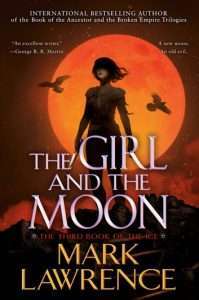 [GdM] After almost a decade of running SPFBO, what have been some of your personal highlights or memorable moments from the competition?
[GdM] After almost a decade of running SPFBO, what have been some of your personal highlights or memorable moments from the competition?
[ML] Oddly, I guess it has to be a book that was failed by the SPFBO in the formal sense. Senlin Ascends didn’t make the final, it was edged out of a finalist spot by Path of Flames (which came 2nd overall – with The Grey Bastards taking 1st). But seeing the publicity lift that book from an obscurity where it looked certain to remain, to a wide audience that it totally deserves, was very heartening.
Otherwise, it’s really ‘just’ seeing a good number of authors really welcoming the attention that the contest was able to focus on their books, gaining them reviews and readers. It’s been really nice to see the finalists each year bond and form friendships / support circles. Lately, they’ve been doing mass zoom-sessions which you can watch on YouTube.
[GdM] Since the competition’s inception, can you see a recognizable impact in the reception of independently published fantasy?
[ML] I think the profile of self-published fantasy has definitely increased over the last 5-10 years. What part the SPFBO played in that is impossible to say. I’m sure the direction of travel would have been the same with or without the contest. But it has been, and continues to be, a fun ride!
[GdM] You have an upcoming release with The Girl and the Moon, the third and final volume in The Book of Ice trilogy. Could you tell us a bit about the trilogy and where we are in the story?
[ML] Grrr… I hate talking about my books. A terrible failing in any author. Can we leave it at “it’s good, read it”?
The story is set on an ice-covered planet and follows the eponymous “girl” on a really long journey where her horizons rapidly broaden from the life she had been living on the edge of survival in the frozen north. (99.999% of the planet is frozen, but the north is COLD with caps).
Our hero, Yaz, has reached a slightly warmer bit of the world by book 3, and the gloves have come off!
[GdM] Did you know the ending of The Book of Ice trilogy when you started writing it?
[ML] I didn’t know the ending halfway through the third book.
[GdM] All of your main protagonists, Jorg, Jalan, Nick, Nona, and now Yaz, all have very distinct voices. I read that you based Jorg on Alex from The Clockwork Orange, and you created Jalan as the opposite of him. What was your starting point for the creation of Yaz?
[ML] My other main characters (with the exception of Nick Hayes in a real-world story, set in 80s London) are fighters – an unwilling one in Jalan’s case, but he knows how to swing a sword and will do so if cornered. With Yaz I wanted someone who, although tough and brave, was not given to violence and not trained with weapons. She’s also the closest I’ve come to a traditional hero, someone motivated by the general good, not prone to anger or selfishness. Hardly groundbreaking, but a change for me.
The books have a theme of hanging on to humanity in the face of implacable pressure to do otherwise. On the ice existence is so precarious that logic dictates there’s no room for weakness, and yet Yaz refuses to surrender to the draconian solutions her society adopts. A starting point for her character was to have someone who would care about these sorts of things and to have the courage to try to do something about it.
[GdM] The Girl and the Stars and The Girl and the Mountain both end with incredible cliffhangers that linger with readers long after putting the books down. From a writing standpoint, did you utilize cliffhangers, so the reader is directly drawn into the next book? Or was it a way to start the next book with a bang?
[ML] Hard to say. Mainly, I guess it was just something new. I haven’t ended books on cliffhangers before (as far as I remember … oh, wait, The Liar’s Key has one, I guess). I like to vary my story, my style, my structure. This was one such variation. The books (especially the first book) are more plot driven than my other stuff, I feel. They’re still character-driven, but the plot and the action get more focus. In some of my earlier books the plot is very secondary to the character. Neither is a bad choice, in my view, just different writing approaches.
A cliffhanger is a double-edged sword. It can encourage readers towards the next book, but also it can discourage readers from starting until the next book is out, if they hear about the cliffhanger’s existence in advance.
[GdM] Can you tell us anything about what is coming next?
[ML] I can! I’m about a quarter of the way through the final book in my next trilogy, which will come out in 2023/4/5.
The first book has as the working title: The Book That Wouldn’t Burn
It’s a story about a vast, possibly infinite, library. Or it’s a story about people whose lives intersect the library. I use the word ‘book’ a lot! But there’s also intrigue, violence, even romance! 
It’s not very grimdark. Unless I really don’t know what grimdark is … then it might be.
Read The Girl and Moon by Mark LawrenceThis interview was originally published in Grimdark Magazine Issue #30.
The post An Interview with Mark Lawrence appeared first on Grimdark Magazine.
April 25, 2022
REVIEW: The Girl and the Moon by Mark Lawrence
Mark Lawrence, the Gemmell Award winning author, master wright of trilogies, curator of the Self-Published Fantasy Blog-Off, and all round nice person has another great book out. I would like to thank Harper Voyager and Mark Lawrence for sending me an advanced reader copy of The Girl and the Moon to be able to review it for Grimdark Magazine. I would also like to thank James Tivendale, of team GdM, for graciously letting me take up his mantle and review The Girl and the Moon for the site after he has so wonderfully reviewed the first two books of the trilogy.
 Mark Lawrence is one of my auto-buy authors. I have never been disappointed with reading any of his works, so I went in to reading The Girl and the Moon expecting it to be a good use of my reading time. The final instalment of The Book of Ice exceeded my already high expectations. It is a fantastic conclusion to the trilogy and my favourite novel out of the three. Anyone who likes Lawrence’s writing will find The Girl and the Moon an enjoyable read. The first two novels of the series, The Girl and the Stars and The Girl and the Mountain are essential pre-reading before attempting to tackle The Girl and the Moon, but you do not need to have read any other of Lawrence’s work to fully enjoy this trio. Although fans of his will absolutely love spotting the ‘Easter eggs’ connecting parts of The Girl and the Moon to the wider Lawrence universe.
Mark Lawrence is one of my auto-buy authors. I have never been disappointed with reading any of his works, so I went in to reading The Girl and the Moon expecting it to be a good use of my reading time. The final instalment of The Book of Ice exceeded my already high expectations. It is a fantastic conclusion to the trilogy and my favourite novel out of the three. Anyone who likes Lawrence’s writing will find The Girl and the Moon an enjoyable read. The first two novels of the series, The Girl and the Stars and The Girl and the Mountain are essential pre-reading before attempting to tackle The Girl and the Moon, but you do not need to have read any other of Lawrence’s work to fully enjoy this trio. Although fans of his will absolutely love spotting the ‘Easter eggs’ connecting parts of The Girl and the Moon to the wider Lawrence universe.
Before The Girl and the Moon properly begins Lawrence gives us a handy summary of ‘the story of far’ which covers the main characters and key plot points from the early two novels. This is a great memory refresher so you can jump straight in to the narrative of this novel without superfluous description or having had to complete a recent reread. After this very brief summary however, The Girl and the Moon takes off at a pace. The first chapter picks up almost immediately after the cliff hanger that Lawrence ended The Girl and the Mountain and boy is the first chapter good. It is a strong opening and Lawrence never lets up from then on. I found The Girl and the Stars and The Girl and the Mountain to be comparatively slower paced novels, and really enjoyed the heightened action and pressures that came with this new setting of The Corridor and the conclusion of Yaz’s journey.
The Girl and the Moon follows Yaz’s perspective and that of other key characters so there are some point of view shifts, but these flow well and never feel jarring or slow the novel down. The last one hundred or so pages of the novel were particularly gripping. The denouement was fantastically executed and not at all what I had predicted or expected. I know Mark Lawrence has previously said that he does not plot out his novels in great detail, so in my mind that makes The Girl and the Moon all the more awesome. Lawrence is nothing less than a genius.
The relationships of the key characters remain the heart of the series and the development of the four who travelled from the ice, Yaz, Quina, Thurin, and Erris, and their friendship was my favourite part of The Girl and the Moon. The new characters introduced in this novel are also a great addition to their cadre and I formed a strong attachment to them quickly. This is essential given the pace of the story but sometimes hard to do when characters arrive in the final part of a trilogy.
There are so many good things about The Girl and the Moon that is impossible to detail them without risking spoiling parts of the novel. It is a spectacular piece of writing and demonstrative of the consistently high standard readers have come to expect from Mark Lawrence. 5/5.
Read The Girl and the Moon by Mark LawrenceThe post REVIEW: The Girl and the Moon by Mark Lawrence appeared first on Grimdark Magazine.
April 24, 2022
REVIEW: The Rush #5 by Simon Spurrier and Nathan Gooden
If the entirety of The Rush could be summed up in two words, I think that “poor Nettie” would be most succinct. More than it has been a story of madness and greed and monsters in the frozen northern wastes, The Rush has become a chronicle of one woman’s grueling odyssey into perdition. It really just never ends for Nettie, and despite her insistence to power through the absolute worst that an insane world full of walking nightmares can throw at her it seems events are shaping up to possibly take our poor heroine down.
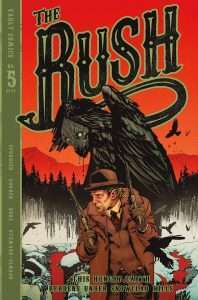 I’m not a believer that every story has to have a happy ending. They do not. Every story simple requires the ending it deserves, and the more I think about it, especially given the events of the fifth and most recent chapter of The Rush, I’ve begun to wonder if it won’t all end in tragedy. At least, I’m doubting whether it’ll end any other way, if it could possibly end any other way. Spurrier is too savvy a writer to pull that kind of bait and switch, especially in a story that has so consistently nailed its tone and so effectively crafted its atmosphere. The world in which The Rush takes place is a grim and heartless one, the narrative that weaves through its pages one of loss and tribulation, and here in this most recent chapter we see that more clearly than ever.
I’m not a believer that every story has to have a happy ending. They do not. Every story simple requires the ending it deserves, and the more I think about it, especially given the events of the fifth and most recent chapter of The Rush, I’ve begun to wonder if it won’t all end in tragedy. At least, I’m doubting whether it’ll end any other way, if it could possibly end any other way. Spurrier is too savvy a writer to pull that kind of bait and switch, especially in a story that has so consistently nailed its tone and so effectively crafted its atmosphere. The world in which The Rush takes place is a grim and heartless one, the narrative that weaves through its pages one of loss and tribulation, and here in this most recent chapter we see that more clearly than ever.
One of the more remarkable things I’ve noticed throughout my time poring over The Rush is how with every issue the art is elevated, and I’m not sure if it’s something that’s actually happening or if it’s simply a phenomenon brought on by my growing fascination with it. Either way, Nathan Gooden is quickly rocketing up my list of artists to keep an eye on in the future. The book wouldn’t be what it is without his contributions, and in that regard, Addison Duke’s colors and textures add profound layers and depth to the visuals. It’s rare that an original series comes out of nowhere like The Rush has and manages to be so singularly well crafted, for the team to be so utterly on point with each other.
In The Rush #5 it feels like The Rush is careening headlong to some kind of horrific climax. It’s a glorious, beautiful inferno screaming down the rails and I cannot look away. It’s heading towards a collision that will leave tragedy and wreckage in its wake and I am completely engrossed in it. There’s no denying that with this issue, The Rush #5 has easily earned five stars and become a strong contender for one of the best series of the year.
Read The Rush #5 by Simon Spurrier and Nathan GoodenThe post REVIEW: The Rush #5 by Simon Spurrier and Nathan Gooden appeared first on Grimdark Magazine.
REVIEW: The Northman
The Northman is a film that should not exist–not at its scale, not in this day and age. It is an unflinching epic of fire and ice, of burning love and cold-served vengeance. It is a story rooted in legend, but most viewers will probably be familiar with the bones of this tale from Hamlet, the Lion King, or Conan the Barbarian. Our protagonist, Prince Amleth, must avenge the death of his father and rescue his mother from the clutches of his uncle (or so he thinks). How director Robert Eggers managed to convince a studio to pay northward of a hundred million dollars so he could adapt this legend into an R-rated, ultra-violent, artistic yet historically-accurate viking film is beyond this reviewer’s ken. But man…am I glad he did!
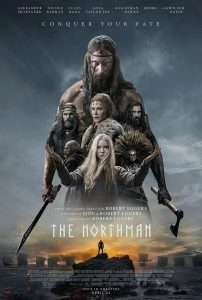 Whether you’re a history buff, cinephile or just looking for an evening’s worth of entertainment, there’s a lot to love about The Northman. The cinematography is gorgeous throughout, making use of firelit interiors, natural exterior lighting, and the stunning vistas of Ireland and Iceland, where much of the film is set. Beauty and horror frequently coalesce on screen, creating a brooding, ominous tone that persists for the majority of the film. Not every scene is filled with blood and thunder, but the ceaseless tension will keep you ever-expectant of the violence to come. There are also a handful of truly impressive single-take shots which help create a frighteningly immersive experience.
Whether you’re a history buff, cinephile or just looking for an evening’s worth of entertainment, there’s a lot to love about The Northman. The cinematography is gorgeous throughout, making use of firelit interiors, natural exterior lighting, and the stunning vistas of Ireland and Iceland, where much of the film is set. Beauty and horror frequently coalesce on screen, creating a brooding, ominous tone that persists for the majority of the film. Not every scene is filled with blood and thunder, but the ceaseless tension will keep you ever-expectant of the violence to come. There are also a handful of truly impressive single-take shots which help create a frighteningly immersive experience.
Eggers’ penchant for hewing close to history when constructing these time-lost settings pays off once again. For a film so occupied with intangible and fantastical concepts–the gods, fate, destiny–it remains refreshingly grounded and tactile. Sure, we see men rise from the dead, gods made manifest, and an unforgettable naked sword fight at the base of a volcano, but despite a few instances of obvious CGI, the costumes, landscapes, and structures offer the texture necessary for transporting viewers to this 10th century setting.
The actors do a fine job overall, as well. While the chemistry between the two leads, Alexander Skarsgård and Anya Taylor-Joy, is inconsistent, the pair do perform well throughout and ultimately sell the emotional punch demanded by the final jaw-dropping action set piece. I would, however, welcome more screen time for the incomparable Willem Dafoe (honestly, who wouldn’t?).
As a massive fan of Robert Eggers’ previous films, The Witch and The Lighthouse, I feel The Northman lacks some of the director’s characteristic weirdness. That isn’t to say the film is totally devoid of the uncanny, or any humorous beats, but I suspect some of Eggers’ special brand of strange got tossed to the cutting room floor. He has stated this is ‘his’ cut of the film, and as true as that may be, I hope to see an extended version at some point.
So, should you go see The Northman? Do you want to see a film that is unafraid of exploring grim aspects of human history and frightening inclinations of human nature? Do you want to feel the unapologetic testosterone pump of Conan the Barbarian and the fire-painted aesthetic of Frank Frazetta’s work? If you want to experience a film unlike most you’ve ever seen or will see again, then, yes, you really need to see The Northman. Gods willing, if this movie manages to become a financial success, we may even be treated to more films like it.
The post REVIEW: The Northman appeared first on Grimdark Magazine.
April 21, 2022
REVIEW: Brothers of the Wind by Tad Williams
Ineluki and Hakatri are brothers, scions of the House of Year-Dancing and princes among the Zida’ya of Asu’a. Brothers of the Wind takes place in Osten Ard, the same setting as Tad Williams’ series Memory, Sorrow, and Thorn and his new trilogy-in-four-books, The Last King of Osten Ard.
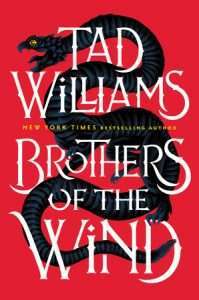 Brothers of the Wind is a prequel detailing the time before humans ruled much of Osten Ard, when most of it was still in the grips of the Sithi. We know Ineluki will become the Storm King, the harbinger of a frozen apocalypse in Osten Ard, and this book states the origins of his fall from a mercurial but loyal prince to the villain of Memory, Sorrow, and Thorn. But the book is not simply the telling of the fall of a tragic hero. We see the reasons for the fall of Ineluki, and the first steps on that path, but not the entirety of it. Much is still left to implication and the imagination.
Brothers of the Wind is a prequel detailing the time before humans ruled much of Osten Ard, when most of it was still in the grips of the Sithi. We know Ineluki will become the Storm King, the harbinger of a frozen apocalypse in Osten Ard, and this book states the origins of his fall from a mercurial but loyal prince to the villain of Memory, Sorrow, and Thorn. But the book is not simply the telling of the fall of a tragic hero. We see the reasons for the fall of Ineluki, and the first steps on that path, but not the entirety of it. Much is still left to implication and the imagination.
Pamon Kes is our narrator, an armiger and servant to Hakatri. He is a changeling, a Tinukeda’ya, not one of the Sithi. However, he has been elevated beyond what any other changeling has been, a fact which gives him no small amount of pride. But the book never shies away from the troublesome nature of this, and how distant this has made him from his people. He does not know his own tongue, does not know any of the stories of his people, and when he wanders into the section of town that has other Tinukeda’ya, his clothing and bearing make him stand out so much that he has to flee.
Pamon Kes felt very much kin to Samwise Gamgee, in his utter devotion to his master regardless of the cost to himself. Through his eyes, Hakatri is a paragon and Pamon is better for being near him. Pamon Kes starts as a more detached observer, content to assist as asked but mostly watching the dynamic between Ineluki and Hakatri. However, he becomes significantly more proactive in the back half of the book.
When a mortal prince asks the Zida’ya for aid against a dragon terrorizing their countryside, Ineluki makes a rash vow to not return home until he has destroyed it. Hakatri follows along, trying to convince him to return home, to wait for more warriors or at least get the witchwood spears necessary from Asu’a. But though Ineluki realizes his oath was foolish, and though everyone tries to convince him that it’s fine and no one will think less of him for breaking it, he refuses to.
The limitations and strictures of such an honor-based society are a huge part of the story. More, it’s not simply the oathmakers who suffer. Ineluki’s oath does not truly bind him save that he chooses for it to, and his brother Hakatri pays the price, being burned by the dragon’s blood. He is scarred and in constant pain afterwards, and Pamon Kes becomes more integral as they search for a cure or a balm for the rest of the book. Knowing that it was his own stubborn pride that caused his brother’s pain fills Ineluki with self-loathing, which makes him lash out at the mortals he’d rather blame.
Xaniko, an exile who fought and slew a dragon years before and has been permanently injured since, also refuses to return to Asu’a, though his wife is clearly dissatisfied. Hakatri makes an oath that he will go face punishment, including execution, for his role in stealing witchwood from another Zida’ya. And Pamon Kes, our narrator, is fiercely loyal to Hakatri even at the cost to his own self. All of them let their own pride and honor rule them, not just at a cost to themselves, but to their loved ones.
Williams is well-known for his long books, but Brothers of the Wind is a perfectly paced stand-alone never feeling like a padded short story or a rushed longer story. It’s a perfect companion piece to his other Osten Ard novels. It has all the hallmarks of Williams—exceptional prose, a slow but methodical pace, and a sense of the mythic that inspires awe.
Read Brothers of the Wind by Tad WilliamsThe post REVIEW: Brothers of the Wind by Tad Williams appeared first on Grimdark Magazine.
April 20, 2022
REVIEW: Demon Dagger By Russell James
Stories of demons and demonic possession have been a lifelong fascination of mine, ever since having watched The Exorcist as a kid. Instead of scaring the pants off me, I was totally engrossed in it. Which probably says a lot about what kind of kid I was, but so it goes. A million years later, and now days when it comes to books and movies about the infernal my interest is usually automatically piqued. Based off its premise and its blurb, Demon Dagger by Russell James is everything I could hope to want about a demonically-centric thriller and it manages to check off all the boxes.
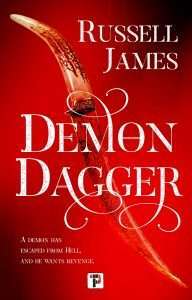 Demons haunting the world wearing human skins, brokering hellish contracts, and creating legions of soulless serial killers? Check. Demon hunters with a curious vision that lets them peel back the curtain on the world and see the nightmares that walk amongst them? Also check. A fast-paced story full of action, violence, and even a good bit of gore? All the checks. Demon Dagger ostensibly operates under a very simple premise: a man who can see demons must save the soul of a loved one from an incalculably evil entity literally hellbent on destruction. There are many, many more layers to the narrative of Demon Dagger, though, with an intricate system to the workings of demons and possession that manages to walk the fine line between fascinating and overbearing. James gives us enough details to be intrigued about how the whole terrifying thing works without drowning the reader in them, or going overboard in exposition. If anything, James moves the narrative of Demon Dagger forward at a brisk pace that meanders little and doesn’t waste time and I for one appreciate that.
Demons haunting the world wearing human skins, brokering hellish contracts, and creating legions of soulless serial killers? Check. Demon hunters with a curious vision that lets them peel back the curtain on the world and see the nightmares that walk amongst them? Also check. A fast-paced story full of action, violence, and even a good bit of gore? All the checks. Demon Dagger ostensibly operates under a very simple premise: a man who can see demons must save the soul of a loved one from an incalculably evil entity literally hellbent on destruction. There are many, many more layers to the narrative of Demon Dagger, though, with an intricate system to the workings of demons and possession that manages to walk the fine line between fascinating and overbearing. James gives us enough details to be intrigued about how the whole terrifying thing works without drowning the reader in them, or going overboard in exposition. If anything, James moves the narrative of Demon Dagger forward at a brisk pace that meanders little and doesn’t waste time and I for one appreciate that.
More than once while reading Demon Dagger I found myself envisioning it adapted into a movie. It’s got a certain tonality to it that lends itself to the cinematic, with big, explosive moments that teeter on the overblown and melodramatic but manage to stay entertaining instead of verging into the unbearable. Demon Dagger is an supernatural action extravaganza, a hellish thrill ride about a world where demonic predators wear fleshmasks and prey upon an unsuspecting humanity. Yet the story is laser focused on a man desperate to save his family, to make them safe, even if he has to sacrifice his own life and soul to do so. That Demon Dagger also has climactic battles with monstrous archdemons and spectacular violence worthy of a summer blockbuster is just a giant bonus.
Demon Dagger is a quick read and a solid four stars, an immensely enjoyable page-turner that wastes no time and will keep you engrossed right from the beginning. I found it hard to put down, because at every turn something interesting was happening and before I knew it the book was over and I was a little disappointed that there wasn’t at least another chapter waiting for me. But I hold out hope that there will be a sequel or two from James in the world of Demon Dagger, as he planted the seeds to follow it up with many more stories.
Read Demon Dagger By Russell JamesThe post REVIEW: Demon Dagger By Russell James appeared first on Grimdark Magazine.
Dances with Devils: Loving the Antihero
Heroes: gotta love ‘em. Take Aragorn, son of Arathorn for instance; he may look a bit foul, but feels fair. He won’t break any legal or moral codes in order to do the right thing—and he will always do the right thing.
Heroes play an important role in literature and entertainment: it is comforting to think that there are genuinely good people out there, somewhere, pure of heart and with a moral compass always pointing true north. Someone who is stronger than the best of us, less tempted to join the dark side. The kind of person you want to have standing watch while you curl up in your bedroll, weary from the day’s adventuring (or the kind of person you want watching your house and feeding your dog when you’re on vacation).
Heroes in fiction tend to be heroes because they’re heroic. Some heroes, like Aragorn, are predestined to be heroes because of family lineage, magical DNA, or some sort of unlooked-for and unearned special quality. Others, such as Kerigan G’ladheon in Kristen Britain’s Green Rider series, are thrust into circumstances which enable and encourage their heroic tendencies to rise to the occasion. In either case, the hero is an innately good person who sets out to achieve a heroic goal and is able to accomplish it because the actions they take are consistently heroic. If they stray from the righteous path, it is but a little.
Heroes are often enabled by a world that supports and rewards heroism. Naomi Novik’s heroic dragon handler, William Lawrence, is a gentleman in a gentleman’s world. Even when he defies societal law in order to follow moral law, it is a heroic and self-sacrificing act which ultimately ends in exoneration. And Novik is very careful to show that the protagonist breaks the law only to effect a heroic goal, only at great personal cost, and only as far as is absolutely necessary. The hero goes out of his way, for instance, to avoid or mitigate harm to innocent bystanders.
Heroes are important. But what happens when the rules of the world are less straightforward, more tarnished, even downright dark? What happens when the would-be hero has to swim against a very strong current in order to achieve a worthy goal? What happens when the king is less honor and truth, more gluttonous exploitation of the unwashed masses? Who will save the day when the laws are unjust and lawmakers corrupt?
Enter the antihero.
An antihero can be explained as a protagonist who lacks at least some of the qualities we expect to see in a traditional hero: courage, veracity, empathy, an uncompromising and uncompromised moral code. They are set apart from villains mainly in that their goal can be seen as deeply relatable, but which the antihero cannot achieve (or at least believes cannot be achieved) through more honorable action.
Some of the more relatable and resonant characters in fiction are antiheroes: Michael Corleone in Mario Puzo’s The Godfather is a young man who has broken away from his mobster friends and family, but when his family is threatened by powerful and degenerate forces, and local law enforcement is on the take, he must return to a criminal way of life and ultimately become the most ruthless of them all.
Jaime Lannister in George Martin’s A Song of Ice and Fire will do anything to be with and protect the woman he loves, and their children. But she’s his twin sister, and married to the king: the only way he can achieve his heart’s desire is through sin and murder. And he’s consistently antiheroic, having killed the king he was sworn to protect in order to put an end to mad and murderous tyranny.
Kissin’ Kate Barlow in Louis Sachar’s Holes just wants to be with the man she loves, but when powerful and wealthy Charles “Trout” Walker has Kate’s lover murdered, she has no legal recourse—Sam is a Black man, and as Walker points out, it is illegal for a Black man to kiss a white woman—Kate turns to vigilante justice and life as an outlaw in order to exact a very gratifying revenge.
William Munny (The Unforgiven, directed in 1992 by Clint Eastwood), is a fine example of an antihero. On the surface, it is a heroic story—a strong fighter seeks to bring bad men to justice for harming a young woman. But this is an antiheroic tale: the young woman is a sex worker, which has both legal and moral ramifications. William Munny is a reformed killer and alcoholic who falls off all the wagons without needing much of a push. His moral compass is so broken that he not only shoots Little Bill Daggett as that villain lies unarmed and vulnerable on the floor, but on his way out the door and out of town Munny also kills a wounded henchman and leaves his friend’s body unburied and on display. Neither did Munny help Delilah out of the goodness of his heart, but for the lowest of all reasons: for money.
William Munny is an antihero and not a villain for one reason only: Sheriff Little Bill is worse. When Delilah is mutilated by a bunch of ranch hands for laughing at one of them, not only does Little Bill reckon her worth only insofar as she is the brothel owner’s property, he also shows himself willing and able to brutalize a group of powerless women in order to block them from seeking justice. This shows the audience that seeking legal redress for Delilah’s injuries will not be possible.
There are far fewer examples of female antiheroes, and too many of these are poorly written. I am not going to waste time discussing the all-too-prevalent storylines of women seeking revenge against their rapists, or those who are hailed as antiheroes but who are little (or nothing) more than an eye candy foil to a superhuman male character, while posing no real threat.
A well-written antihero can create strong emotional resonance in the reader. A character who desperately wants to achieve a relatable and admirable goal—love, justice, safety—but who is prevented from reaching that goal by a corrupt power structure is highly relatable. We can empathize as the protagonist tries time and again to achieve their goal through legitimate means only to suffer as a result until, pushed beyond a breaking point, they must aside the bonds of law and morality and finally, painfully, become the antihero their world cries out for.
After all, who hasn’t longed to dance with the devil in the pale moonlight?
Dances with Devils: Loving the Antihero by Deborah A. Wolf was originally published in Grimdark Magazine Issue #30.
The post Dances with Devils: Loving the Antihero appeared first on Grimdark Magazine.
April 19, 2022
REVIEW: The Wolf and the She-Bear by Morgan Stang
Morgan Stang’s novella, The Wolf and the She-Bear, examines the consequence of choice and the internal struggle between before and now. Mixing a creative approach to fantastical lore with a low fantasy setting, Stang adds a dash of humor and a sprinkle of western sensibility into a tale of monsters, love, respect, and violence.
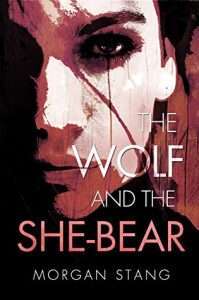 Escaping the past is an idealistic dream, or so mercenary Samantha Redwyne finds out for herself in The Wolf and the She-Bear. After hiding from her ghosts by going north, an old acquaintance appears with a job offer: protect a wagon full of wolf skins on its journey to the next village where they can be sold for profit. Anything that sounds easy rarely is as Samantha quickly realizes with the arrival of a band of criminals in search of the very wagon Samantha has agreed to defend. Past and present collide as betrayal and survival color the world in an ever-lasting shade of red.
Escaping the past is an idealistic dream, or so mercenary Samantha Redwyne finds out for herself in The Wolf and the She-Bear. After hiding from her ghosts by going north, an old acquaintance appears with a job offer: protect a wagon full of wolf skins on its journey to the next village where they can be sold for profit. Anything that sounds easy rarely is as Samantha quickly realizes with the arrival of a band of criminals in search of the very wagon Samantha has agreed to defend. Past and present collide as betrayal and survival color the world in an ever-lasting shade of red.
The Wolf and the She-Bear’s opening lines hooked me immediately. Each chapter begins with the fragments of a letter – the contents directly serving as an insight into one of the main characters. This balances with the overarching narrative as the story progresses to heighten the tension both internally and externally. Stang’s characters are fleshed out, real, and command the reader’s investment. The multiple perspectives lend themselves to not only the story, but the world Stang has created, specifically in regard to the lore. The book also has clever quips of humor whether directly in dialogue or the situations the characters find themselves in, lightening the tone of some otherwise bleak moments. Although together, the story elements blend and work well, the shining aspect of the novella is Stang’s attention to payoff. The reveals and solutions to each conflict are purposeful, satisfying, and consistent.
Grimdark fans will appreciate Stang’s complex cast of characters, the balance of brutality with spots of humor, and the strong thematic elements, especially the difficulties of reconciling with the past. Each point-of-view in The Wolf and the She-Bear feels humanly individual and weaves in interesting lore while quickly pushing the story forward to its conclusion. The book’s themes compliment Stang’s writing style and reflect aspects of our own world: “It’s all about respect. Dogs are like people, I’ve found. Some of them are respectful, and some of them are fucking assholes.”
The Wolf and the She-Bear is set in the same world as Stang’s series, Bartram’s Maw, and the standalone novel, The Spider and the Scribe. Each book can stand on its own with a connecting overarching plotline. Based on Stang’s ability to interweave effective characterization and plot with excellent payoff in under 200 pages, I’m excited to read more of their work.
Read The Wolf and the She-Bear by Morgan StangThe post REVIEW: The Wolf and the She-Bear by Morgan Stang appeared first on Grimdark Magazine.
April 17, 2022
REVIEW – The Chosen Twelve by James Breakfield
The Chosen Twelve by James Breakwell touts itself as a Lord of the Flies and Phillip K. Dick type story. For the most part, it does hit those marks without straying too far into either one to be uncomfortable for readers. Which I think is this story’s most significant flaw. The subject matter should be uncomfortable. However, even with me wishing that Breakfield took a much bigger leap to the dark side, this is a great novel that I thoroughly enjoyed.
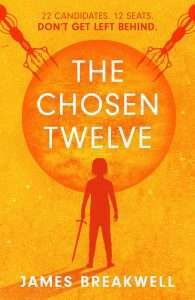 The Chosen Twelve starts with, “God lived in the coffee maker on deck four. Only Gamma Knew.” Gamma, one of humankind’s last organic beings, is standing before a door that may or may not be trying to kill him. On the other side of this door might be God. If only he could make it through this door.
The Chosen Twelve starts with, “God lived in the coffee maker on deck four. Only Gamma Knew.” Gamma, one of humankind’s last organic beings, is standing before a door that may or may not be trying to kill him. On the other side of this door might be God. If only he could make it through this door.
You see, in Gamma’s world, most of the machines are trying to kill the organics. Their programming has fizzled and popped and, in many cases, gained sentience. The machines have learned that humans should die. If Gamma steps through this door, he could be crushed to death. But on the other side, there might be answers. Gamma’s life has been long, and he has been kept in the proverbial dark by the machines that control his survival. But like a man searching for water in the desert, Gamma believes that he can get answers if he can just make it through this door.
Gamma runs through the door, but the door is too quick and catches his arm and almost severs it. He begins to scream, but the ship is so big and full of so many things trying to kill him; the odds are that he will die with his arm trapped like a bear caught in a bear trap.
The “children” of the story, all 22 of them, are the last humans in the universe. The artificial intelligence that controls their ship grew them from embryonic form with the help of another machine designated, Edubot. The 22 fledgling humans were raised and educated according to the machine’s ultimate goals. The humans would survive and help repopulate a planet and serve the machines. Thus helping create new computers from the raw materials on the colonized planet, they found. The children also live exceptionally long lives, with the help of technology, but are kept at the physical maturation age of 12.
They are 12 years old, but not really.
The machines waited until the right moment to send the children to the planet and begin reconstruction, and that time is now.
Conflicts arise with the AI that controls the humans and with each other. We get our Lord of the Flies moments with that many different personalities and skill levels and only 12 seats to go to the planet. Humans can be real bastards to each other when there are scarce resources.
I enjoyed the characters of Gamma and Delta quite a bit. They stood in stark contrast to some of their classmates—especially Delta, who raised herself above her classmates in both skill and desire for a better world. The cast of characters is very long, named for the Greek alphabet, and they drop like flies. You care a great deal about some characters, while others pass by like a ship in the night.
Even with the level of deceit and violence the characters display, it doesn’t venture near enough into the darkness of the human psyche for me to honestly believe in the predicament they face. These aren’t children; their bodies belie the minds encased within, and I would expect them to act as such. Delta comes close, though. She starts to understand the necessity of some of her choices and feels the moral burden they entail.
There are certainly some very dark moments and bloodshed in The Chosen Twelve. The fight scenes are frenetic and well-written. It was hard for me to imagine swords in space like this, but Breakwell makes it work.
This is a highly imaginative novel. The predicaments the characters face are just shy of excessive and ridiculous, but if anything is possible, the highly imaginative and crazy can become plausible. Almost cherry-flavored food rations that you have to beg machines for, check. A robot that thinks of itself as a king, check. A metallurgist making swords that can cut through anything, check. Breakwell makes the scenarios work. And while I couldn’t entirely shed disbelief, I was highly entertained by the dark comedy, fight scenes, and narrative.
I think The Chosen Twelve story engages readers who like their science fiction and fantasy on the darker side, but not so dark that it is pitch black. Breakwell makes this highly imaginative story work and it is worth reading.
Check Out The Chosen Twelve by James BreakfieldThe post REVIEW – The Chosen Twelve by James Breakfield appeared first on Grimdark Magazine.



